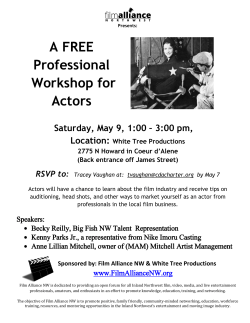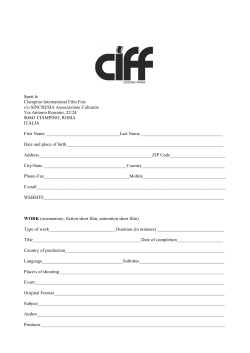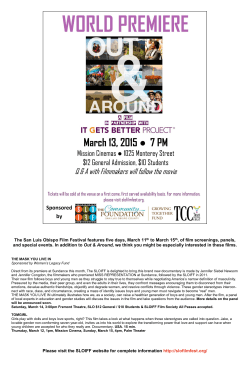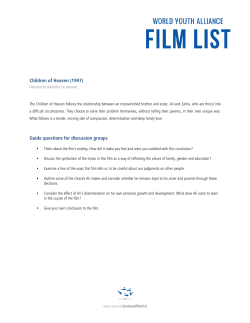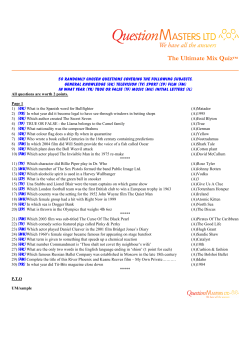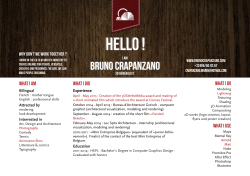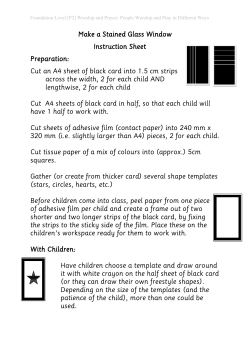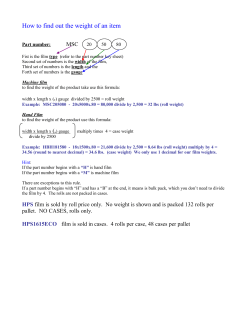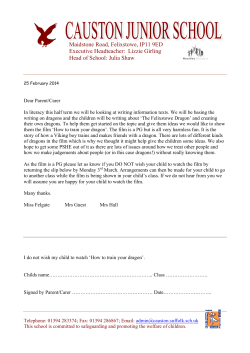
Food, Inc. Viewing Guide - Moeller American Literature, Mr. Eble
Food, Inc. Viewing Guide Mr. Eble, CP1 Sophomore English As we watch Food Inc., please complete the following questions. You’ll dropbox your work when we’re finished with the film. Fast Food to All Food 1.) What problems do the opening narration and the scanning through the supermarket reveal? 2.) “This isn’t just about what we’re eating; it’s about ______________________.” 3.) According to Eric Schlosser, how does Fast Food connect to Industrial Food? 4.) Explain what is happening on the corporate food level, and how that is changing how we eat. 5.) “In a way, we’re not producing chickens; we’re producing ________________.” 6.) Below, write some of the problems for farmers, chickens, and consumers in the poultry business. A Cornucopia of Choices 1.) What illusion does Michael Pollan note about grocery stores? 2.) Explain the Farm Bill (or, as Pollan calls it, the Food Bill) 3.) How does Food Inc demonstrate the ever-presence of corn in our food system? (Explain the visuals the film uses to do so). 4.) What effect does an all-corn diet have on cows? Explain how this affects consumers. Unintended Consequences 1.) How does Food Inc. use pathos and logos at the start of this chapter with news reports? 2.) Explain how Food Inc. uses logos via statistics throughout the opening of this chapter. 3.) Describe Barbara Kowalcyk’s role in food advocacy, particularly Kevin’s Law. How does the film appeal to pathos in this section through her testimony? How does it also appeal to logos through her acquired knowledge? 4.) Kowalcyk’s says, “Sometimes it feels like ___________________________ was more protected than my son.” 5.) According to Michael Pollan, what is the food industry’s primary focus? What is its fix for problems in feedlots and cattle? (particularly when e coli breakouts occur) The Dollar Menu 1.) How does this section rely upon the example of the Gonzalez family to develop each of the appeals (logos, ethos, pathos) to support the film’s claims about diet and cost of food? 2.) What does Michael Pollan say about “bad calories,” cost of food, and commodity crops and the biggest predictor of obesity? How does his testimony build ethos and logos? In the Grass 1.) What does Joel Salatin demonstrate about the problem with corporations making food decisions? 2.) Explain the contrast in this chapter between Smithfield and Joel Salatin’s farming methods. 3.) How does this chapter demonstrate the problems of the workers in the pork industry? 4.) How does the example of The Jungle and meatpacking develop logos for the film’s claim in this section? 5.) Explain the role of immigration in the meatpacking industry. Hidden Costs 1.) According to the opening farmer’s testimony, to what extent is industrial food “not honest food?” 2.) Why does Salatin claim that he doesn’t want to be involved with Walmart? 3.) What alternative does Gary Hirschberg, the CEO of Stonyfield Farms, offer to the industrial model? Explain what perspective he provides for the film’s central claim (particularly in regards to the American economy and capitalism). 4.) What does Hirschberg say about WalMart’s motivations? (“moral enlightenment?”) From Seed to the Supermarket 1.) What “new idea” does Michael Pollan note in regards to corn and patents? 2.) What claim of fact (and/or value) does this part of the film seem to make about Monsanto? How? How does the film use farmer testimony (along with music) throughout this chapter to develop all three of the appeals? 3.) Explain the title of this chapter. The Veil 1.) What “revolving door” does Pollan note in regards to Monsanto and government? Why, does he claim, this has influenced the lack of debate about food issues? How does the opening of this section use visuals and music to present this argument? 2.) The film shifts back to Barbara Kowalcyk in this section; what does her testimony aid to the claim in this part? 3.) What are Veggie Libel Laws and Cheeseburger Laws? Shocks to the System 1.) Pollan says “We eat a lot of oil.” What does he mean? 2.) How does this section of the film demonstrate a claim of value about our current food system? (which the film’s ending claims of policy illustrate) 3.) What power does Hirschfeld locate in consumers? How do the testimonies by Pollan, Schlosser, Salatin, Kowalcyk, and other folks contribute to the film’s claim of policy and appeal to logos and pathos in this section? 4.) Why does the film end with Bruce Springsteen singing “This Land is Your Land?” Please dropbox your work.
© Copyright 2025
